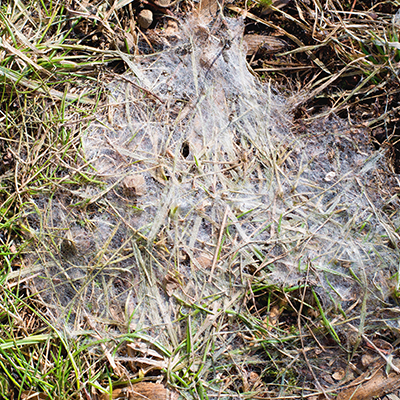Those of us who live in and around Central and South Brevard County are blessed in many ways. We are surrounded by miles of pristine sandy beaches and the crisp cool waters of the Atlantic ocean. Add in the numerous parks, trails, nature preserves, and Indian River Lagoon; it’s like being on vacation year-round. But living in such proximity to the sea has its downfalls. One of these includes the hurricanes and tropical storms we sustain. Even when these weather incidents aren’t catastrophic, there is a lot of rain. This rain, mixed with heat and drought of a Florida summer can create the perfect environment for various fungi and lawn diseases to grow. Maintaining a healthy lawn through a comprehensive lawn care program will help, but it’s also important to recognize when a problem occurs. Read on as we discuss a few common lawn fungi ready to destroy your Brevard County turf and how you can help prevent this.
Grey Leaf Spot
Grey Leaf Spot loves Florida’s wet, warm, and humid climate. This disease is caused by fungi and primarily affects perennial ryegrass and tall fescue but can infect St. Augustine turf as well. It progresses rapidly, and once it infects, it destroys your leaf blades. It’s identifiable by the tan or grey spots growing on your leaves and typically grows in shaded areas under trees and around fences. As the fungus spreads, it can infect your stems and spikes. During high periods of rain, you may see a water-soaked border around actively growing spots. Grey Leaf Spot not only weakens your grass but can kill it, leaving your turf open and susceptible to weed growth and other diseases. The best way to prevent this unsightly fungus is to avoid using too much nitrogen on your lawn and apply it early in the morning and water only as needed.
Dollar Spot
Another common lawn fungus that creeps up and wreaks havoc on our Brevard County turfs is good ole Dollar Spot. It is called such because it appears on your lawn as white, tan, or straw-colored round patches about the size of a silver dollar. It loves our damp, warm, tropical conditions. As it spreads, multiple dollar spots merge, forming larger patches. Dollar spot rears its ugly head at the start of spring when the humidity is high, and the temperatures start to reach 70 degrees.
The best way to prevent Dollar Spot is to through proper lawn fertilization and irrigation. Using fertilizer will help keep your grass strong and more resistant to Dollar Spot, while proper irrigation will help minimize damp conditions. When watering, only do so in the early morning before sunrise. This will give your grass more time to dry. You can also invest in annual aeration services to help keep proper airflow moving through your grass at all times.
Rust Fungus
Rust Fungus makes your Brevard County lawn appear like someone took a bottle of yellowish-brown powder and sprinkled it across your yard. It doesn’t just make your yard look like a rusty old car; the powdery substance also sticks to your shoes, lawnmower, pet’s paws, and anything else that walks across your turf. This sticky fungus starts to sprout when the temperatures reach between 68 and 85 degrees, and lots of rain has just occurred It prefers shade, heat, and humidity, all the makings of our tropical climate. You can help prevent Rust Fungus by growing a thick, healthy turf. Fertilize with a nitrogen-based fertilizer, but not too much nitrogen, and irrigate properly. Minimize the amount of shade your grass receives and revitalize your lawn once a year with aeration to help break up thatch and assist with better drainage.
Brown Patch
Finally, let’s talk about Brown Patch. This devastating lawn fungus appears as large circular irregular patches of dry, dead grass. It typically shows up when the grass is saturated from recent storms and when the temperature drops below 68 degrees, which is different than the others we listed who appear when it’s warm. Here in Brevard County, Florida, that is typically in late fall and early spring when our grass has less daylight to dry out. It spreads rather quickly, and as it does, the infected grass withers and dies allowing weeds to invade and take over and other fungi to grow. The best way to prevent Brown Patch is similar to how you prevent other fungi from occurring, through good lawn practices. Fertilize, aerate and practice good irrigation techniques. Sitting water can give Brown Patch life, so never overwater your lawn and always make sure it drains properly.
Protect Your Brevard County Lawn With a Lawn Care Program by Flowers Turf and Pest Management
All of these lawn fungi have one thing in common, they all grow in moist, oversaturated conditions. During hurricane season, it’s hard here in Brevard County to predict how much rainfall we will get and if we will get too much. The best way to protect your grass is by maintaining a healthy lawn. Flowers Turf and Pest Management can help you do that. Our lawn care program, known as our six-step nutritional package, will provide your lawn with the appropriate amount of nutrients, broadleaf weed control, and green-up it needs. And it will do all of this without including any of the dangerous phosphorus that ends up in our waterways. Our six-step nutritional package was designed to help protect your turf while combating disease, fungi, and pests. Contact us to learn how we can start protecting your turf today. Reach out to us via our online contact form, or give us a call at 321-254-1929.
Did you find the above article helpful? Feel free to share it with your family and friends. Then check out our other monthly blog articles here. Are you on social media? We are too. Check out our Facebook page!

